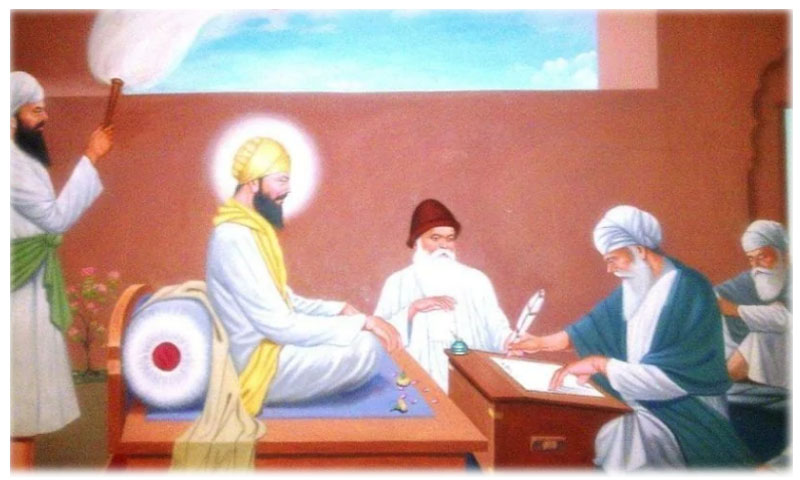 Sikh
Sikh
The enlightened path: Unveiling the legacy of Sri Guru Angad Dev
It is widely known that Guru Angad is the second Sukh Guru. What is relatively unknown, however, is that he formalized the present ‘Gurmkhi’ script and started the ‘Mal Akhara’ to educate his followers about physical well-being parallel to spiritual development.
Guru Nanak Devji, the founder of Sikhism, appointed Guru Angad as his successor. Knowing the prowess and far-sightedness of the former, it can be easily understood that this event had implicit importance in the evolution and outreach of Sikhism as the second Guru’s sublime teachings foster universal brotherhood based on mutual love and understanding.
As known by recorded history, Guru Angad was born in 1504, called Bhai Lehna by his friends and relatives, in the village Matte-de-Sarai in Sri Mukhtasar Sahib District. ‘Angad’ means ‘limb Guru Nanak Nanak Deviji’ and the latter certainly did justice to this christening!
Lehna was a Hindu by birth and was married to Mata Khivi, the couple had two sons and two daughters. Although Lehna was a devout follower of Mata Durga and took the annual pilgrimage to the Jwalamukhi temple, there was a spiritual vacuum in his life. The story goes that he once heard a Sikh hymn and fell in love with its content, on enquiring about its creator, he was informed that it was written by Guru Nanak Devji of Kartarpur. Lehna was keen on meeting the Guru and incidentally on his way over, asked the Guru himself for directions to his house, unknowingly. The Guru, instead of directing him, took his horse’s saddle strings and led him to his own house. When Lehna came to know about his folly, he was deeply embarrassed and asked Nanakji for forgiveness. The Guru smiled, and replied, “Don’t worry, when someone comes to take something, they would come as you have (as ‘Lehna’ means to take something), if you give me the strings of your mind as you did with the horse saddles and let me direct you, you will be amazed…”.
There are many ‘Sakhis’ or anecdotes that talk about Lehna’s unquestionable devotion and loyalty to Nanak Devji. One of the most significant ones tells that once while traveling through the forest, Nanak made gold and silver coins appear before his group but only Bhai Lehna and Bhai Budda did not run to pick them up. Then Nanak led them to a funeral pyre and ordered both of them to eat the corpse hidden under the shroud. While Bhai Buddha stood thinking, Lehna lifted the shroud to obey his Guru and found ‘Prasad’ under it instead of a dead body. He offered the same to the Guru, satisfied to feed off his leavings. After this Nanak revealed the ‘Japuji’ to Bhai Lehna and proclaimed him as the next Guru.
After 7 years of intense devotion, Nanak named him ‘Agad’ in 1539 at Kartarpur. Guru Angad left Kartarpur after Nanak’s demise and set towards ‘Khadoor Sahib’ (near Goindwar Sahib) and carried forward the principles of Guru Nanak in both; letter and spirit.
“Austerity and everything come through immersing oneself in the meditation of the Lord’s name. All other actions are useless. O Nanak, believe in the One who is worth believing in. By Guru’s Grace, he is realized.”
– Guru Angad
Angad Devji was both, a spiritual teacher and a man of action and insisted that harmony between thought and action led to a pure life. Hence, he believed ardently in the concept of ‘Sewa’ as the path to achieving enlightenment was only through selfless service, good deeds, and devotion and worship of one God.
“Eliminate your conceit and then perform service to humanity, only then you will get the honor.”
Guru Angad staunchly believed in equality between castes, classes, and genders. He always set himself as an example and showed dignity and equality of women through his relationship with his wife, Mata Khivi, who in turn, lived out his teachings beautifully with her actions. She pioneered women’s empowerment by establishing women-centric roles in leadership and took forward the concept of ‘Langar’ by feeding people who came to visit her husband, regardless of their caste, religion, race, or gender.
The second Guru’s actions were interlaced with his teachings. He popularized that a sound mind could only thrive in a healthy body and thus, stressed on need for physical exercise after morning prayers and encouraged wrestling bouts or ‘Mal Akharas’ to compete in physical competitions. This was another medium through which he wanted to do away with the taboo of lower caste masses being restricted to having physical contact with those belonging to upper castes. This strengthened the foundation of a healthy Sikh community without barriers of caste and creed.
As mentioned earlier, one of Guru Angad’s major contributions to Sikhism was the development of the Sikh alphabet which gave people the ‘Gurmukhi script’ in which the hymns of the Gurus were recorded. This measure had a two-fold impact; firstly, it was instrumental in giving Sikhs an individual identity, enabling them to express their thoughts freely without hassles of translation and, secondly, it led to the growth and development of their own social and religious practices which were dissociated from Sanskrit religious traditions. He also started several schools for children so that more and more people would become literate. Angad Devji himself was a great teacher, providing education to the downtrodden people in order to empower them to achieve greater goals in life. He also initialized the first biography of Guru Nanak Devji, with the help of Bhai Bala’s verbal accounts in 1844, and wrote 63 verses which were later included in Guru Granth Sahib by the fifth Guru.
Guru Angad nominated Guru Amar Das as his successor and presented him with all holy scriptures as he became ‘jyoti jot ‘ on 29th March 1552 at the age of 48. The now-existing town of Goindwal Sahib was commissioned to be constructed by him, which came to be supervised by the ‘Third Nanak’ eventually. Such was the aura and reverence of Angad Devji that deposed Mughal Emperor, Humayun, also came to seek the former’s blessing to regain the throne of Delhi for Sher Shah Suri.
This era in Guruship and the establishment of Sikhism was a very crucial one because due to positive reinforcement and balanced leadership of Guru Angad, Sikhism blossomed from a bud to a gorgeous flower, spreading beauty and fragrance to all those who came in its vicinity.
(Image and Text credit: Khalsavox.com)
Support Our Journalism
We cannot do without you.. your contribution supports unbiased journalism
IBNS is not driven by any ism- not wokeism, not racism, not skewed secularism, not hyper right-wing or left liberal ideals, nor by any hardline religious beliefs or hyper nationalism. We want to serve you good old objective news, as they are. We do not judge or preach. We let people decide for themselves. We only try to present factual and well-sourced news.







